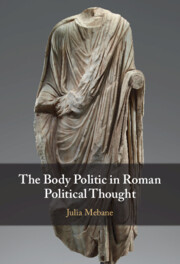Book contents
- The Body Politic in Roman Political Thought
- The Body Politic in Roman Political Thought
- Copyright page
- Dedication
- Contents
- Acknowledgments
- Introduction
- Chapter 1 The Divided Body Politic
- Chapter 2 The Sick Body Politic
- Chapter 3 The Augustan Transformation
- Chapter 4 Julio-Claudian Consensus and Civil War
- Chapter 5 Addressing Autocracy under Nero
- Conclusion
- Works Cited
- Index Locorum
- Index
Conclusion
Published online by Cambridge University Press: 01 February 2024
- The Body Politic in Roman Political Thought
- The Body Politic in Roman Political Thought
- Copyright page
- Dedication
- Contents
- Acknowledgments
- Introduction
- Chapter 1 The Divided Body Politic
- Chapter 2 The Sick Body Politic
- Chapter 3 The Augustan Transformation
- Chapter 4 Julio-Claudian Consensus and Civil War
- Chapter 5 Addressing Autocracy under Nero
- Conclusion
- Works Cited
- Index Locorum
- Index
Summary
The Conclusion uses the downfall of Nero to consider the legacy of the body politic metaphor in Roman political thought. Julio-Claudian writers relied on the duality of head and body to express fears about the recurrence of civil war. Without a head to command Rome’s warring limbs, they argued, Rome would return to its ancestral cycle of self-destruction. The Year of the Four Emperors confirmed the prescience of their warnings. Plutarch and Tacitus relied on symbolism of a headless body politic to describe the conflict, confirming their perception of sole rule as necessary if not ideal. This contest for power therefore did not weaken the Principate so much as confirm its viability as an institution independent of its Augustan origins. With the rise of the Flavians came the formalization of both sole rule and the Imperial model of the body politic for centuries to come.
Keywords
- Type
- Chapter
- Information
- The Body Politic in Roman Political Thought , pp. 195 - 204Publisher: Cambridge University PressPrint publication year: 2024

